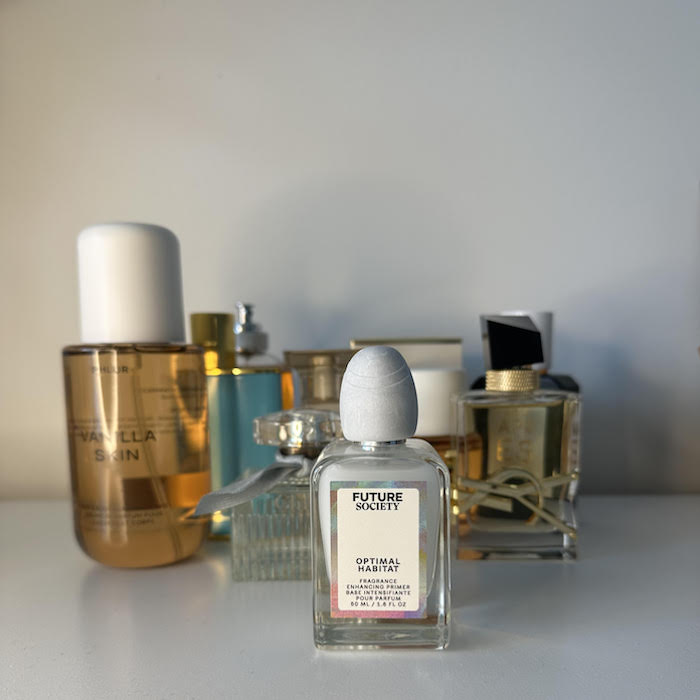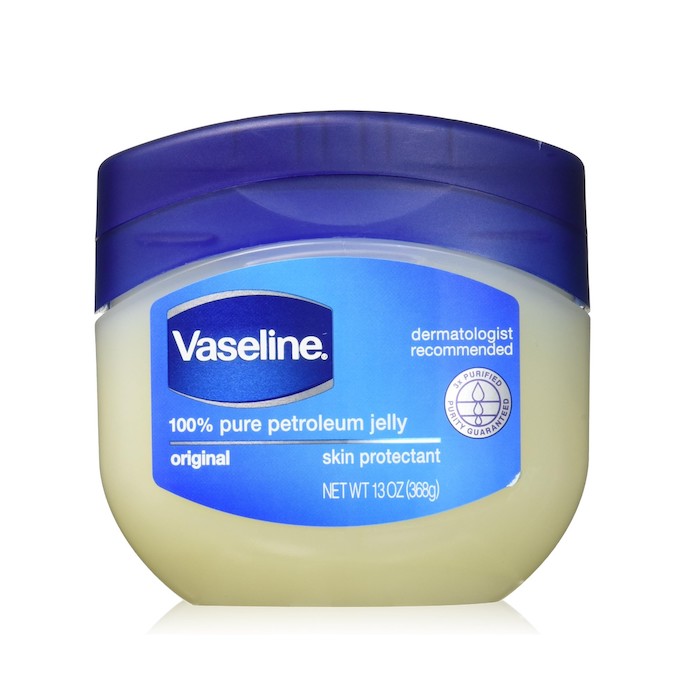I Tried a "Fragrance Primer" to See If It Actually Makes My Perfume Last Longer

I'm a beauty editor, so it's no surprise that I love fragrance… and I mean love. I own over 25 bottles of perfume. They're sitting on my dresser right now, painting the wall behind it in varying shades of gold, amber, and rose, depending on the color of the liquid inside. My little apothecary of perfume brings me joy and allows me to switch up my scent based on the situation and season that I'm in.
There's only one thing that I don't love about fragrances, and that's the fact that some of them simply don't last. I'll spritz them on my pulse points in the morning, and they don't even linger until lunchtime. No matter how sweet, sultry, or intoxicating a perfume smells, it's simply not worth it if it doesn't stick around—especially when that scent has an expensive price tag.
So, what's a girl to do? Well, there's always fragrance primer. Yes, you read that right. Fragrance primer exists, and just like makeup primer, it's designed to prep the skin for and extend the wear of the products that follow it (in this case, your favorite perfume). The latest one to launch promises to keep scent locked to your skin for up to 24 hours. So obviously, I had to try it.

Here's the product in question. It's formulated by Future Society, the fragrance brand that's known for creating scents using the DNA from extinct flowers. Just like the brand's other products, this fragrance primer is built on biotechnology. It contains ingredients that moisturize, soothe, and prime the skin's natural microbiome to create the optimal pH for fragrance to flourish. The brand promises that it can extend the wear of your favorite fragrance for up to 24 hours. That's impressive, but is it true?

The ingredients include standard moisturizing and skin-softening ingredients like glycerin and squalane, as well as biotech ingredients. These include:
Aeonome: a marine ingredient that moisturizes and soothes the skin while reducing oxidative stress and supporting the microbiome.
Ceramide NP: an ingredient derived from olive oil that plays a critical role in the skin's outer layers.
Sr-Hydrozoan Polypeptide-1: an ingredient that's similar to marine collagen and supports the skin's moisture and antimicrobial barriers.
How's that for high-tech? Together, these ingredients not only prime the skin for fragrance, but they extend the wear of fragrance and even intensify it upon application. In other words, it promises to amplify your favorite perfume and save you from having to reapply it throughout the day, saving you money in the long run.

I was curious about how this product would feel and smell. Upon first look, I figured it would be slightly viscous thanks to its milky-white color, but when I spritzed it on my wrists, it felt lightweight and all but disappeared after a few seconds. There was virtually no residue and it felt more like a hydrating mist than anything. As for the smell, there was none.
I applied it to my wrists and neck, let it dry for 30 seconds, and then applied perfume.
Experiment #1: Body Mist

Fragrance Notes: Pink pepper, pink apple, sugar, lily, jasmine petals, cashmere wood, vanilla, sandalwood, agarwood
I wanted to test this fragrance primer on all different types of scents, and I started with body mist. This one, from Phlur, is one of my all-time favorites. I've been wearing it nonstop for months, and I'm familiar with how long it lasts, so I felt like it was a good starting point. Usually, it lasts about four hours until I have to reapply it. When I applied it on top of the fragrance primer, it lasted for about six hours. I spritzed it on at noon, and at dinnertime, when my boyfriend asked, "Why do you smell so good?" Success.
Experiment #2: Eau de Toilette

Fragrance Notes: Grasse rose, lily of the valley, patchouli
Next up was an eau de toilette. I reached for a classic—this traditionally feminine scent. Usually, this lasts about four to five hours before I feel the need to reapply it. Similar to my first experiment with the body mist, the wear time was extended by a couple of hours (somewhere around six or seven). I could still very obviously smell it on my wrists at dinnertime. Once again, success.
Experiment #3: Eau de Parfum

Fragrance Notes: lavender, orange blossom, musk accord
Now for the main event. Eau de parfum usually contains 15–20% fragrance and should last somewhere between six to eight hours. On me, it only ever lasts about five. But when I sprayed this sultry scent on top of the fragrance primer, it lasted for about eight hours. I know that because I sprayed it on at noon and I got complimented on my perfume at 8 p.m.
Bonus Experiment: Cologne

Fragrance Notes: Ambrette seeds, sea salt, sage
Did you know that eau de cologne usually only has 2–5% fragrance concentration, and thus lasts only 1-2 hours at a time? While I'm completely and utterly obsessed with Jo Malone fragrances, they really don't last long for me. Usually, when I spritz one on my wrists and neck, it will last maybe two hours if I'm lucky. As such, I was dying to try one of my favorite ones on top of this fragrance primer.
Spoiler alert: it increased the wear time (somewhere around three or four hours). While this wasn't the 24-hour longevity I was hoping for, it was still an improvement.
The Verdict

While I can confidently say that this fragrance primer extends the longevity of my favorite perfumes, there's no hard-and-fast rule as to how well it works. Based on my experience, I feel like it depends on the specific fragrance you're pairing it with. Still, though, I can see how this can come in handy—especially when it's paired with lighter, fresher, and more fleeting fragrances.
It's worth noting that some dermatologists say petroleum-based products, like Vaseline and Aquaphor, can work as fragrance primers in that they hold onto perfume and extend its longevity. While these don't contain the same hydrating, soothing, and microbiome-supporting ingredients as the Future Society Fragrance Primer, they're inexpensive and accessible. Personally, I'll stick with the actual fragrance primer to avoid thick, greasy residue on my wrists and neck.
Shop More of My Favorite Fragrances

Kaitlyn McLintock is a Beauty Editor at Who What Wear. She has 10 years of experience in the editorial industry, having previously written for other industry-leading publications, like Byrdie, InStyle, The Zoe Report, Bustle, and others. She covers all things beauty and wellness-related, but she has a special passion for creating skincare content (whether that's writing about an innovative in-office treatment, researching the benefits of a certain ingredient, or testing the latest and greatest at-home skin device). Having lived in Los Angeles, California, and Austin, Texas, she has since relocated back to her home state, Michigan. When she's not writing, researching, or testing beauty products, she's working through an ever-growing book collection or swimming in the Great Lakes.






